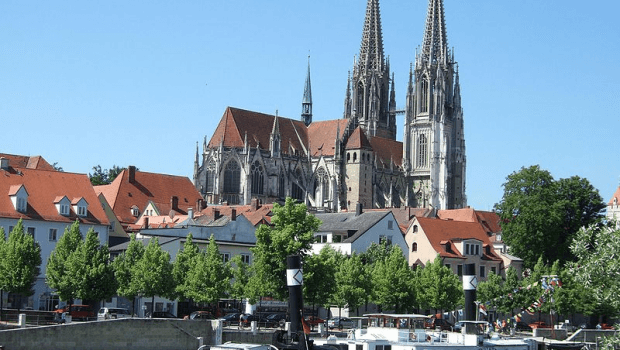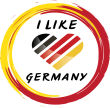
Regensburg Kathedrale: The Regensburg Landmark
The Regensburg Kathedrale or Regensburg Cathedral is dedicated to Saint Peter and is considered as one of the most important landmarks and church of the German city of Regensburg. The church is also the seat of the Catholic diocese of the city of Regensburg. The church due its magnificent architecture serves as one of the prime examples of Gothic architecture in the Bavarian region of Germany.
The overall length of the interior of the cathedral measure about 85.40m while the width of the interior is about 34.94m. The height of the nave of this cathedral is about 31.85m and the height of the bell towers in the cathedral is about 105m.
History of Regensburg Kathedrale
At the very same spot where the famous Regensburg Kathedrale today stands, a first bishop’s church stood in the year 700 AD. In the year 739, Saint Boniface chose the Northern gate of the Roman fort as the seat of the bishop and the current site of the cathedral remained the same since then. The cathedral then went a refurbishment during the Carolingian times and was expanded considerably during the 11th century AD. In this century two towers, an atrium and a fifteen-meter wide transept was added to the cathedral.
Between the years 1156 and 1172, the edifice was burnt to ground twice. In the year 1273, the cathedral was then rebuilt in High Gothic style architecture. In the year 1320, the cathedral’s three choirs were ready to be used and during the same time, the old cathedral was completely demolished in order to accommodate the new one. Between the years 1385 and 1415, to the western side of the cathedral, the work of the main entrance was finally completed. The newest edifice of the cathedral was finished in the year 1520 and the construction of the cloister was completed between the years 1514 and 1538.
During the seventeenth century, a cupola built at the crossing of the transept and a couple of other sectors went under the refurbishment process. King Ludwig the First of Bavaria had commissioned a refurbishment process of the cathedral between the years 1828 and 1841. This led to the alteration of the cathedral’s architecture to a neo-gothic style. The cupola of the cathedral was demolished and baroque styled frescoes were relocated within the cathedral. The cupola now was replaced by a rib vault which was quadripartite in nature. The spires and the towers carrying them were built here between the years 1859 and 1869. With the erection of the spire and the transept gable, the construction of the cathedral finally culminated. If calculated overall, the total amount of years taken to build this cathedral stands about six hundred years.
In the year 1923, the building workshop of the Regensburg Kathedrale was founded. This was done keeping in view the restoration, maintenance and oversight of the Regensburg Kathedrale. In the year 1980, the erection of the crypt mausoleum and the archaeological exploration of the nave were done. During the beginning of the twenty-first century, the Regensburg Kathedrale was finally fully restored.
The Architecture of Regensburg Kathedrale
The most unusual and striking feature of the Regensburg Kathedrale is the disjunction between the main structure and the cloister which was constructed earlier. This disjunction between the two came when the Regensburg Kathedrale was rebuilt. The cloister was then moved to the southwestern side of the older cathedral built in Romanesque architecture.
In the memory of the older cathedral, Eselsturm tower today stands towards the northern side of the Regensburg Kathedrale. As in the olden days, even today this is used to transport and lift heavy construction material to the higher levels of the cathedral. On the western loft, a giant pulley still stands today and it is through the help of this pulley that materials are transported. There is one opening in the ceiling located near to the western portal that serves as an opening to carry the materials higher to the upper levels of the Regensburg Kathedrale.
Towards the eastern side of the Regensburg Kathedrale lies the building workshop, which is used even today to maintain the cathedral. The tools used for the renovation projects of the Regensburg Kathedrale are built in this very same workshop. This can be noticed in the making of the tools in itself, as they are neither too old and nor too modern in their make.
Erminold Maria is an important element in the Regensburg Kathedrale and is used by the Annunciation group here. This dates back to the Erminoldmeister, who is responsible for the beautifully colored and carved figure of Mary and the Angel Gabriel who stands laughing. This dates back to the year 1280 AD. At the cross of the nave, these two beautiful figures juxtapose each other, located on the two pillars on the western side of Regensburg Kathedrale. In the figure, Mary raises her hand indicating to the angel, while her left-hand holds one book to which she points her finger.
In the year 1320 and 1370 respectively, the figures of Saint Paul and Saint Peter were carved on the eastern pillar.
On the exterior of Regensburg Kathedrale, you can notice a Judensau or Jew’s Sow. This is depicted in form of sow and three Jews dangling to its teats. In the year 2005, there was a controversy surrounding the information depicting this picture.
The glass windows of the Regensburg Kathedrale were installed here between the years 1220 and 1230 and, 1320 and 1370. The windows located on the western façade were completed during the nineteenth century. The windows located on the left chancel came to being between the years 1967 and 1968. This was done by the skillful hands of Professor Oberberger. The windows located on the northern and western side of the transept and the windows of the clerestory were also designed by him in Gothic style architecture.
Built between the years 1695 and 1785, the high altar in silver was made by the Augsburg artists. The most striking feature of this silver high altar is the five altars for reservation. In the year 2004, artists Helmut Langhammer built a southern choir which was the newest altar for celebration.
Located in the central nave, Saint Peter Canisius preached here between the years 1556-1557.
Important attachments to Regensburg Kathedrale
- Saint Peter
Saint Peter who is also popularly known as Simon Peter, Simon or Simeon, is one of the twelve apostles of the Christ, according to the New Testament. He is also known as the apostle of the apostles, which was rendered to him by the third-century Roman theologian Hippolytus. The Roman Catholic Church located in the Vatican City has branded him as the first pope.
According to the New Testament, Peter is considered as the son of Jonah or John. He came from Bethsaida, a village located in Galilee, a province. From the same source, Peter is also considered one of twelve apostles that Jesus himself chose from his followers.
According to the popular Christian tradition, the Emperor Nero Augustus Caesar had crucified Peter in Rome. It is believed that Peter requested Nero that he be crucified upside down as he denied Jesus three times when the messiah needed him the most and considered himself unworthy to be crucified the same way as Jesus was crucified.
- Roman Catholic Diocese of Regensburg
The Diocese of Regensburg is the ecclesiastical territory of the Roman Catholics and is seated here in Regensburg, located in Germany. This district covers the northeastern side of the Bavarian region of Germany and falls as subordinate to the archbishop of Freising and Munich. This diocese has over a million Catholics, which constitutes a total of over eighty percent of the population. The bishop who currently oversees this diocese is Bishop Rudolf Voderholzer. The central church under it is the Regensburg Kathedrale. This diocese is distinguished into seven hundred sixty-nine parishes under thirty-three deaneries under a total of eight regions. This covers a total region of a little over fourteen and a half thousand kilometre square.
Regensburg and places to visit
Regensburg City is located on the southeastern side of Germany, at the meeting point of Naab, Regen and Danube Rivers. This city is the fourth largest city in the Bavarian region of Germany, with about one lakh forty thousand inhabitants. Regensburg is popularly known as the cultural. The Economic and political center of the Eastern Bavarian region and is also the capital of Bavarian administration of the Upper Palatinate.
The medieval center of the Regensburg us a United Nations Educational Scientific and Cultural Organization’s (UNESCO) certified Heritage site of the world. This is done keeping in view of the city’s cultural heritage which reflects the heritage of the entire southern Germany. Regensburg is popularly known as Ratisbona in Spanish, Italian and Portuguese, Ratisbonne in French and Ratisbon in English.
Main Attractions in the city of Regensburg:
- The Dom or the Cathedral
- The Stone Bridge
- The Sausage Kitchen of Regensburg
- The Church of Saint James
- The Church of Saint Ulrich
- The Church of Obermunster
- The Alder Apotheke
- The Golden Tower or the Goldener Turm
- The Old Town Hall
- The Golden Cross Inn
- The Gothic Villa of the King of Bavaria
- Saint Emmeram’s Abbey
- The city Park
- The Botanical Garden
- Herzogspark
